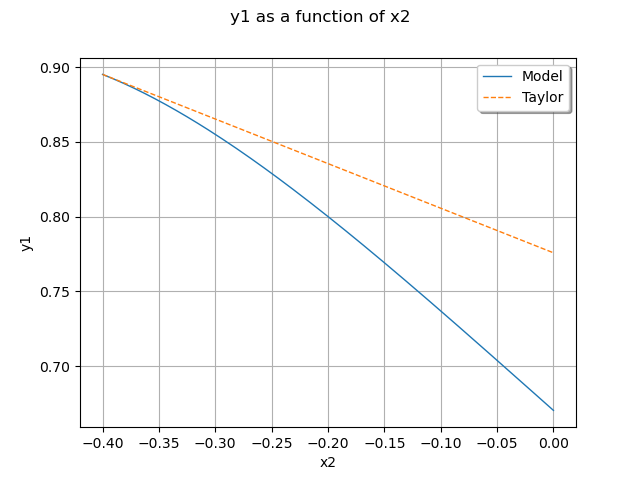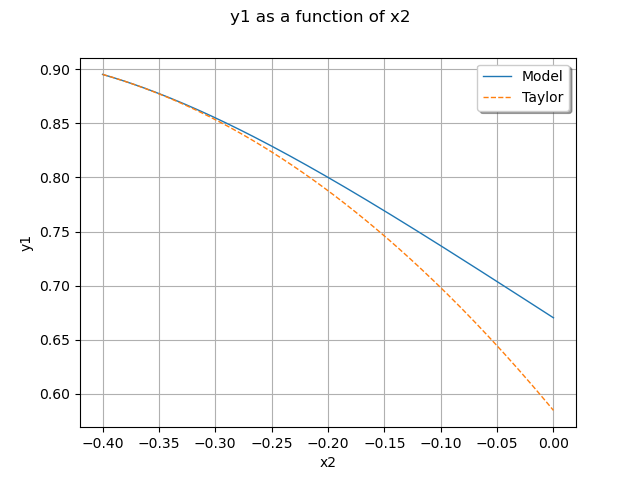Note
Go to the end to download the full example code.
Taylor approximations¶
In this example we build a local approximation of a model using the
Taylor decomposition with the LinearTaylor class.
We consider the function defined by:
for any .
The metamodel
is an approximation of the model
:
for any . We note
,
the marginal outputs
In this example, we consider two different approximations:
the first order Taylor expansion,
the second order Taylor expansion.
import openturns as ot
import openturns.viewer as viewer
ot.Log.Show(ot.Log.NONE)
Define the model¶
Prepare some data.
formulas = ["cos(x1 + x2)", "(x2 + 1) * exp(x1 - 2 * x2)"]
model = ot.SymbolicFunction(["x1", "x2"], formulas)
Center of the approximation.
x0 = [-0.4, -0.4]
Drawing bounds.
a = -0.4
b = 0.0
First order Taylor expansion¶
Let be a reference point where
the linear approximation is evaluated.
The first order Taylor expansion of the output marginal
is:
for any .
Create a linear (first-order) Taylor approximation.
algo = ot.LinearTaylor(x0, model)
algo.run()
responseSurface = algo.getMetaModel()
Plot the second output of our model with .
graph = ot.ParametricFunction(model, [0], [x0[1]]).getMarginal(1).draw(a, b)
graph.setLegends(["Model"])
curve = (
ot.ParametricFunction(responseSurface, [0], [x0[1]])
.getMarginal(1)
.draw(a, b)
.getDrawable(0)
)
curve.setLegend("Taylor")
curve.setLineStyle("dashed")
graph.add(curve)
graph.setLegendPosition("upper right")
view = viewer.View(graph)

Second order Taylor expansion¶
Let be a reference point where
the quadratic approximation is evaluated.
The second order Taylor expansion of the output marginal
is:
for any .
Create a quadratic (second-order) Taylor approximation.
algo = ot.QuadraticTaylor(x0, model)
algo.run()
responseSurface = algo.getMetaModel()
Plot second output of our model with .
graph = ot.ParametricFunction(model, [0], [x0[1]]).getMarginal(1).draw(a, b)
graph.setLegends(["Model"])
curve = (
ot.ParametricFunction(responseSurface, [0], [x0[1]])
.getMarginal(1)
.draw(a, b)
.getDrawable(0)
)
curve.setLegend("Taylor")
curve.setLineStyle("dashed")
graph.add(curve)
graph.setLegendPosition("upper right")
view = viewer.View(graph)

view.ShowAll()
 OpenTURNS
OpenTURNS